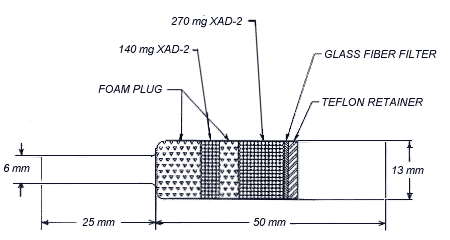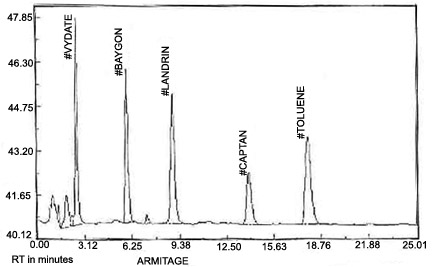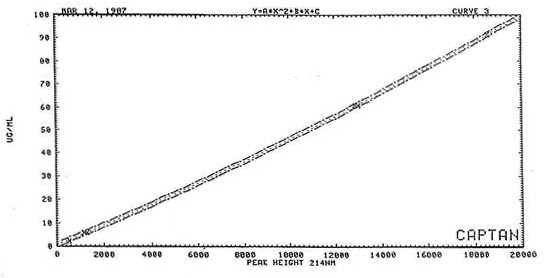1. General
Discussion
1.1 Background
1.1.1 History of
Procedure
This evaluation was
undertaken to determine the effectiveness of the OVS-2 sampling device
for captan. It follows the procedure developed for carbaryl.
(Ref. 5.1)
It should be noted that in this evaluation for
captan several other analytes were also present in the
analytical procedure. These other analytes are not mentioned in this
evaluation, but can be seen on the sample chromatogram. (Sec.
3.5.2)
1.1.2 Toxic effects (This section is for
information only and should not be taken as the basis of OSHA
policy).
The acute oral LD50 for rats is
12.5 ± 3.5 g/kg, with death mostly occurring during the third and
forth days. A National Cancer Institute
carcinogenesis bioassay completed in 1977 was positive for mice.
However other bioassays for mice and rats have been negative. (Ref.
5.2)
There are indications that captan may
cause skin irritation in some workers. (Ref. 5.2)
Based
on the available toxicity data captan has been given a TLV of 5
mg/m3 by the ACGIH. (Ref.
5.2)
1.1.3 Potential workplace
exposure
No estimate of worker exposure to captan could
be found. The estimated production of captan in 1972 was 17 million
pounds. Captan is used as a protectant-eradicant fungicide. (Ref.
5.3)
1.1.4 Physical properties (Ref.
5.3-5.6)
| Molecular weight: |
300.61 |
| Molecular formula: |
C9H8Cl3NO2S |
| CAS #: |
133-06-2 |
| Melting point: |
175șC |
| Appearance: |
white, crystalline,
odorless solid |
| Solubility |
in g/100 mL of solvent
at 25șC
acetonitrile 3.6
methanol 0.5
xylene 6.5 |
| Synonyms: |
Captaf, Captex, Herpan,
Orthocide, Pillarcap |
| Chemical name: |
cis-N-(trichloromethylthio)-4-cyclo-hexene-1,
2-dicarboximide. |
| Structure: |
 |
1.2 Limit defining parameters
The detection limit of the analytical procedure is 6 ng
per injection. This is the amount of analyte which will give a
peak whose height is approximately five times the baseline noise.
2. Sampling
procedure
2.1 Apparatus
2.1.1 Samples are collected
by using a personal sampling pump that can be calibrated to
within + 5% of' the recommended flow rate with the sampling device in
line.
2.1.2 Samples are collected with OVS-2 tubes,
which are specially made 13-mm o.d. glass tubes that are tapered to 6
mm o.d.. These tubes are packed with a 140-mg backup section and a
270-mg sampling section of cleaned XAD-2. The backup section is
retained by two foam plugs and the sampling section is between one
foam plug and a 13-mm diameter glass fiber filter. The glass fiber
filter is held next to the sampling section by a
polytetrafluoroethylene (PTFE) retainer.

2.2
Reagents
No sampling reagents
are required.
2.3 Sampling
technique
2.3.1 Attach the small end
of the OVS-2 sampling tube to the sampling pump with flexible,
plastic tubing such that the large, front section of the sampling tube
is exposed directly to the atmosphere. Do not place any tubing in
front of the sampler. The sampler should be attached vertically (large
end down) in the worker's breathing zone in such a manner that it does
not impede work performance.
2.3.2 After sampling
for the appropriate time, remove the sampling device and seal the tube
with plastic end caps.
2.3.3 Wrap each sample
end-to-end with an OSHA seal (Form 21).
2.3.4 With each
set of samples, submit at least one blank. The blank should be handled
the same as the other samples except that no air is drawn through
it.
2.3.5 Bulk samples should be submitted for
analysis in a separate container. Do not ship with the air samples.
2.4 Extraction
efficiency
Two 13-mm glass fiber
filters were each liquid spiked with 299.2 ”g of captan. These two
filters, along with a blank filter, were each placed in separate 4-mL
vials which also contained 270 mg of XAD-2 adsorbent. These vials were
stored overnight at room temperature, and then extracted with 2 mL of
acetonitrile.
The average extraction efficiency for these two
filters (with the XAD-2 adsorbent present) was
90%.
2.5 Retention
efficiency
Two OVS-2 tubes were
each spiked with 299.2 ”g of captan by liquid spiking the 13-mm
glass fiber filter. Sixty liters of humid air were drawn through each
tube. The two tubes were then extracted as in Section 3.4. No
significant breakthrough to the backup section was
observed.
The average retention efficiency for these two
tubes was 92%.
2.6 Sample
storage
Two OVS-2 tubes were
each spiked with 299.2 pg of captan as above. Sixty liters of
humid air were drawn through each tube. These two tubes were stored for
seven days at ambient temperature in a drawer. They were then extracted
as in Section 3.4. No captan was recovered from the backup
section of these tubes.
The average recovery after seven
days of storage was 82%.
2.7
Recommended air volume and sampling rate
2.7.1 The recommended air volume is 60
L.
2.7.2 The recommended flow rate is 1.0
L/min. 2.8 Interferences
It is not known if any compounds will interfere with the
collection of captan. Suspected interferences should be reported to the
laboratory with submitted samples.
2.9 Safety precautions
2.9.1 Attach the sampling equipment in
such a manner that it will not interfere with work performance or
employee safety.
2.9.2 Follow all safety practices
that apply to the work area being sampled.
3. Analytical
procedure
3.1 Apparatus
3.1.1 A high-performance liquid
chromatograph equipped with a UV detector, and manual or
automatic injector. A Waters M6000A pump, Waters 710B autosampler, and
Waters 440 UV detector with an extended wavelength module were used in
this evaluation.
3.1.2 An HPLC column capable of
separating captan from any interferences. A 25 cm Ś 4.6 mm i.d. DuPont
Zorbax ODS (6 micron) column was used in this
evaluation.
3.1.3 An electronic integrator or other
suitable means of measuring detector response. A Hewlett-Packard 3357
data system was used in this evaluation.
3.1.4 Vials,
4-mL glass with PTFE-lined septa.
3.1.5 Volumetric
flasks, pipets, and syringes for preparing standards, making
dilutions, and performing injections. 3.2 Reagents
3.2.1 HPLC grade acetonitrile
(ACN).
3.2.2 HPLC grade water. A Millipore
Milli-Q system was used to prepare the water for this
evaluation.
3.2.3 Captan, 99% pure (Chem Services
Inc.). 3.3 Standard
preparation
Stock standard
solutions are prepared by adding acetonitrile to preweighed amounts of
captan. Working range standard solutions are prepared by diluting stock
solutions with acetonitrile. Stock and dilute standards are stored in a
freezer.
3.4 Sample
preparation
3.4.1 Transfer the 13-mm glass
fiber filter and the 270-mg section of the sampling tube to a 4-mL
vial. Place the first foam plug and the 140-mg section in a
separate vial. A small glass funnel can be used to facilitate the
transfer of the adsorbent. Discard the rear foam plug. Do not
discard the glass sampling tube; it can be reused after it has been
cleaned with surfactant or suitable solvent.
3.4.2
Add 2.0 mL of acetonitrile to each
vial.
3.4.3. Seal the vials with PTFE-lined
septa and allow them to extract for one hour. The vials should be
shaken by hand periodically during the one hour extraction
time. 3.5
Analysis
3.5.1 Instrument
conditions
| Column: |
25 cm Ś 4.6 mm
i.d. stainless steel column, packed with 6 micron DuPont Zorbax
ODS |
| Mobile Phase: |
45% ACN / 55% water
(v/v) |
| Flow rate: |
1 mL/min |
| UV detector: |
214 nm |
| Retention time: |
13.7 min |
| Injection volume: |
10
”L |
3.5.2
Chromatogram

3.6
Interferences
3.6.1 Any compound having a
similar retention time to the analyte is a potential interference.
Generally, chromatographic conditions can be altered to separate an
interference from the analyte.
3.6.2 Retention
time on a single column is not proof of chemical identity.
Analysis by an alternate HPLC column, detection at another wavelength,
comparison of absorbance response ratios, and confirmation by mass
spectrometry are additional means of identification.
3.7 Calculations
3.7.1 A calibration curve is
constructed by plotting detector response versus standard
concentration.

3.7.2 The concentration
of captan in a sample is determined from the calibration curve. If
captan is found on the backup section, it is added to the amount found
on the front section. Blank corrections for each section should be
performed before adding the results together.
3.7.3 The
air concentration is then determined by the following formula:

3.8 Safety
precautions
3.8.1 Avoid exposure to all
standards.
3.8.2 Avoid exposure to all
solvents.
3.8.3 Wear safety glasses at all times.
4. Recommendations
for further study
There appears to be some loss of captan
with storage at ambient temperature. A more statistically valid storage
study should be done to clarify this tendency. This method should be
fully validated. 5.
References
5.1 Burright, D., Method #63,
"Carbaryl (Sevin)", OSHA Analytical Laboratory, unpublished,
1987.
5.2 "Documentation of the Threshold Limit
Values and Biological Exposure
Indices", American Conference of Governmental Industrial
Hygienists Inc., fifth edition, 1986.
5.3 "Substitute
Chemical Program, Initial Scientific and Minieconomic Review of Captan",
U.S. Environmental Protection Agency, Office of Pesticide
Programs, Criteria and Evaluation Division, Washington, D.C.,
April 1975.
5.4 "Farm Chemicals Handbook", Meister
Publishing Co., 1985.
5.5 Windholz, M.,
Ed. "Merck Index", 10th ed.; Merck and Co., Rahway, NJ,
1983.
5.6
"Chemical Information File", U.S. Department of
Labor, Occupational Safety and Health Administration, Directorate of
Science, Technology and Medicine, June 14,
1985.
|

